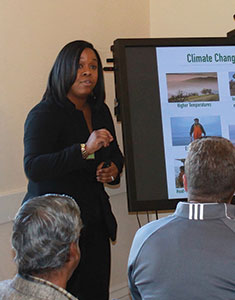John Martello
John Martello ’76, M.S. psychology, held a number of key positions during his lengthy and influential career at the university, including vice provost for the Division of Professional Studies, chairman and CEO for UMBC Training Centers, and founder and executive director of The Shriver Center. (He will officially retire at the end of the Spring 2016 semester.)
What follows are edited excerpts from a recent UMBC Magazine interview with Martello.
Read our full story about how staff built UMBC’s infrastructure for postgraduate success.
On the path from applied learning programs at UMBC to The Shriver Center:
I got to UMBC in 1974 as a graduate student, and I did that full time for two years, at which point I took a grant-funded job, which was to establish the Cooperative Education Program.
I thought I do that for a year or two, and continue on with my doctoral studies. But I never really left UMBC, and I really enjoyed it, and proceeded to establish a number of programs and kind of get promoted along the way, and eventually finish my Ph.D.
As hard as it is to believe now, back in the 70s and 80s, the feeling of our faculty – and, at most universities, this was true – was that education is best which occurs in the classroom. Which, artfully stated, means we don’t really support internships, or co-ops, or God forbid, service learning. So we went from not having a university-centralized applied learning enterprise to having one. And it became one of the best ones in the state, if not the nation. It also formed a nucleus on which the Shriver Center was built.
The Shriver Center was a model of applied and service learning and service delivery – meaning the university would actually deliver services, not just do research or other traditional kinds of work with community-based programs. We actually developed and operated these programs, and some we kept – like the Choice program – and some we spun off.
The Choice program has certainly expanded, and it has survived Republican and Democratic administrations and budget-tightening, because its outcomes are so extraordinary, and it’s as simple as that. Even the most prudent cost-cutting analyst looks at Choice and says, “The cost not to do this would be higher than to do it.” Not only the social cost, but the economic cost.
The other great program was the Peaceworker Program, which Tim Shriver created conceptually as a gift to his father, Sargent Shriver. We became the headquarters for that initiative after a short stint at Georgetown University. The program continues to produce leadership for the city.
The majority of our Peaceworker graduates live and work here, and these are individuals from all over the country who attended wonderful undergraduate programs including UMBC, but some of the Ivy Leagues and top public universities as well. And they’ve demonstrated their commitment to work with thorny problems. What a great resource they are, intellectually, for Baltimore.
On UMBC’s innovative Training Centers:
Applied learning and service learning and professional studies and the training centers all fit under the term “engagement.” That term is bandied about, but in UMBC’s case, it’s the authentic belief that theory and knowledge creation – which is what universities have traditionally done – inform practice. But also that practice informs theory. So, for a variety of reasons, at different levels –some practical, some philosophical – UMBC has really taken the lead in engagement.
That means both the application of knowledge aimed at gaining productive work (applied learning, service learning) and our professional master’s programs and other applied and professional programs, which bring us closer to the professional community and working professionals.
UMBC Training Centers is unlike anything I’m familiar with nationally, because it is an LLC owned by a public university. There are probably other universities that control LLCs, but UMBC is unique in the Training Centers’ mission, application of knowledge, and ability to equip professionals with skills that they need today. We’ve moved non-credit training from something pedestrian to something that is popular and in demand. Three times, our LLC was identified as among the fastest-growing companies in the nation.
We serve community employers, but they help us with industrial advisory boards, and by empowering our students, supporting our students, and creating settings for interns and co-ops. We talk about multi-level partnerships. And it’s a more authentic and reciprocal engagement that’s academically based.
UMBC Training Centers became part of the institutional fiber, part of the mission and values. I think it makes us very unique. And it’s why we survived this terrible economy, because our students were having problems and challenges just like everyone else. But it’s pretty well known that UMBC graduates are quite good, and they managed to get employment because of who they were and what they had done, and the culture and programs at UMBC.
On balancing ambition and resources:
UMBC, in my experience, has always been – we call it “entrepreneurial,” but it’s probably “intrapreneurial.” Always with a huge ambition, and an outsized vision that couldn’t possibly be supported with the resources at hand. But instead of giving up or being despondent, or saying we’ll wait until the money comes in, we figure out a way to do things aimed at quality, hope, ambition, and desire to be the best. This connection to the world has served us well, because we generate resources, and we extend our reach and reputation.
How can you beat that, right? That’s my view. The theme that runs through my career – and I wish I could say I planned it this way – but it’s kind of doing God’s work at a profit. You elevate minds and spirits, but you do it in a way that manages not only to break even, but contributes resources for the important missions the university has that aren’t fully funded. So it’s perfect; it’s doing good work, and it’s revenue-positive.
Tags: Winter 2016



